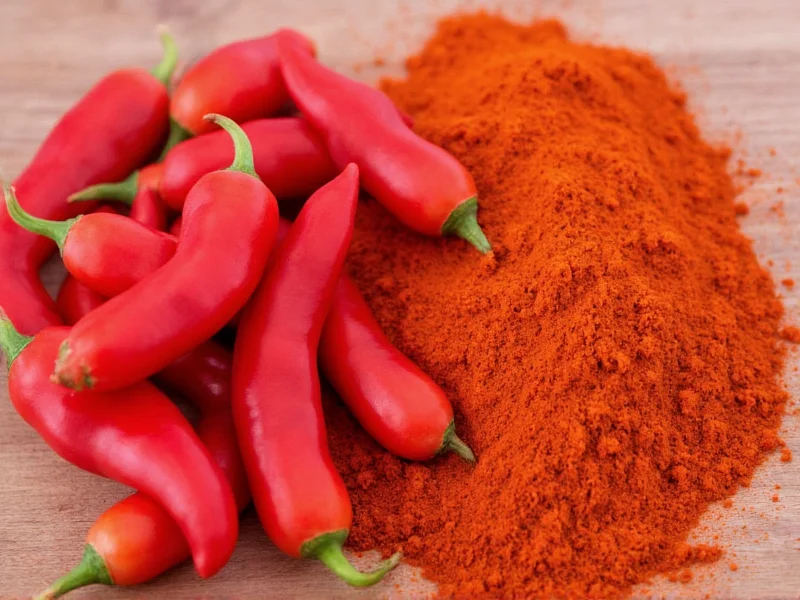Understanding the distinction between chili and cayenne pepper is essential for home cooks and culinary enthusiasts. Many recipes specify one or the other, yet confusion persists about their differences, heat levels, and appropriate uses. This comprehensive guide clarifies these commonly mixed-up ingredients with botanical accuracy and practical cooking insights.
Botanical Origins and Classification
Both chili and cayenne originate from the Capsicum genus, but they represent different classifications within this family. Cayenne pepper comes specifically from the Capsicum annuum var. annuum species, typically measuring 30,000–50,000 Scoville Heat Units (SHU). True cayenne peppers are slender, tapered, and ripen from green to bright red.
Conversely, “chili” is a broader term. In fresh form, it refers to numerous Capsicum varieties—from mild bell peppers (0 SHU) to fiery habaneros (100,000–350,000 SHU). When recipes mention “chili powder,” they're usually referring to a North American spice blend containing ground chilies (often ancho or cayenne), cumin, garlic powder, and oregano—not pure ground chilies.
| Characteristic | Cayenne Pepper | Chili Powder | Individual Chili Peppers |
|---|---|---|---|
| Composition | 100% ground cayenne peppers | Blend: chilies + cumin, garlic, etc. | Single pepper variety |
| Heat Level (SHU) | 30,000–50,000 | Variable (500–5,000) | 0–350,000+ (varies by type) |
| Flavor Profile | Sharp, immediate heat with subtle fruitiness | Earthy, complex (due to added spices) | Varies widely by variety |
| Common Forms | Ground powder or fresh peppers | Ground powder only | Fresh, dried, smoked |
| Primary Culinary Use | Heat boost in sauces, rubs, eggs | Tex-Mex dishes, chili con carne | Varies by pepper type and cuisine |
Heat Level Comparison: Understanding Scoville Ratings
One of the most critical differences lies in heat intensity. Cayenne pepper consistently delivers significant heat at 30,000–50,000 SHU—about 12 times hotter than a jalapeño. This makes it a go-to for those seeking pronounced spiciness without overwhelming complexity.
Chili powder's heat varies dramatically based on its blend. Commercial versions typically range from 500–5,000 SHU, with most landing in the mild-to-medium spectrum. The confusion intensifies because some chili powder blends contain cayenne as a primary ingredient, while others use milder chilies like ancho.
When comparing individual fresh chili peppers, the spectrum widens considerably. Understanding this difference between chili and cayenne pepper heat levels prevents recipe disasters—adding cayenne when a recipe calls for mild chili powder could make a dish inedibly hot.
Flavor Profiles and Culinary Applications
Cayenne offers a clean, straightforward heat with minimal flavor complexity beyond its intense spiciness. Chefs use it when they want heat without altering a dish's fundamental flavor profile—ideal for hot sauces, spice rubs, or adding kick to scrambled eggs.
Chili powder provides layered flavor due to its spice blend composition. The cumin, garlic, and oregano create an earthy, aromatic base essential for authentic Tex-Mex dishes like chili con carne or enchilada sauce. This distinction between chili powder and cayenne pepper explains why substituting one for the other often yields disappointing results.
Regional variations further complicate matters. In the UK and some Commonwealth countries, “cayenne” often refers to any ground red pepper, while “chili” specifically denotes the fresh peppers. In Mexican cuisine, recipes typically specify particular chili varieties (like guajillo or pasilla) rather than generic “chili powder.”
Substitution Guidelines: When and How to Swap
Understanding the difference between chili powder and cayenne pepper is crucial for successful substitutions:
- Using cayenne instead of chili powder: Use 1/4 teaspoon cayenne for every tablespoon of chili powder, plus 1/2 teaspoon cumin and a pinch of garlic powder to approximate the flavor profile
- Using chili powder instead of cayenne: Not recommended for heat-focused applications, but in complex dishes, use 1 tablespoon chili powder per 1/4 teaspoon cayenne
- For authentic Mexican dishes: Seek specific dried chilies (ancho, guajillo) rather than generic chili powder
When substituting, always consider whether the recipe needs pure heat (cayenne) or complex flavor (chili powder). This practical understanding of the difference between red pepper and cayenne prevents culinary mishaps while maintaining recipe integrity.
Common Misconceptions Clarified
Several persistent myths confuse home cooks:
- “Cayenne is just hot chili powder”: Incorrect—cayenne is a single-ingredient powder, while chili powder is a blend
- “All red pepper flakes are cayenne”: Most red pepper flakes contain multiple chili varieties, not pure cayenne
- “Chili powder is always mild”: Some specialty blends incorporate significant heat from cayenne or other hot chilies
The confusion between chili vs cayenne heat level comparison stems partly from inconsistent labeling practices. Always check ingredient lists—if it contains only “ground cayenne peppers,” it's pure cayenne; if it lists multiple spices, it's chili powder.
Practical Selection Guide for Cooks
When choosing between these ingredients, consider your recipe's requirements:
- Choose cayenne when: You need pure, intense heat without additional flavors (hot sauces, spice rubs, Bloody Marys)
- Choose chili powder when: Building foundational flavors in Tex-Mex dishes (chili con carne, tacos, fajitas)
- For authentic results: Seek specific dried chilies (ancho, chipotle) rather than generic blends
Storage matters too—both lose potency over time. Keep them in airtight containers away from light and heat. Properly stored, cayenne maintains heat longer than chili powder, whose blended spices degrade at different rates.
Conclusion: Mastering the Distinction
Recognizing the difference between chili and cayenne pepper transforms your cooking precision. Cayenne delivers straightforward heat, while chili powder offers complex flavor. Understanding their composition, heat levels, and appropriate applications ensures your dishes achieve intended results. When in doubt, check labels for ingredients—this simple practice resolves most confusion about chili powder composition ingredients versus pure cayenne pepper.











 浙公网安备
33010002000092号
浙公网安备
33010002000092号 浙B2-20120091-4
浙B2-20120091-4